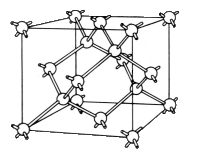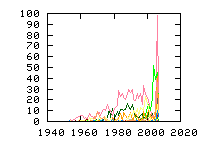« Previous
1
Next »
(14 hits, 1/1)
Showing
10, 25, 50, 100, 500, 1000, all papers per page.
Sort by:
last publication date,
older publication date,
last update date.
- 1. phys. stat. sol. (b) 245, 1298-1314 (2008) , “EPR identification of intrinsic defects in SiC”, J. Isoya, T. Umeda, N. Mizuochi, N. T. Son, E. Janzen, T. OhshimaThe structure determination of intrinsic defects in 4H-SiC, 6H-SiC, and 3C-SiC by means of EPR is based on measuring the angular dependence of the 29Si/13C hyperfine (HF) satellite lines, from which spin densities, sp-hybrid ratio, and p-orbital direction can be determined over... (Read more)Si SiC diamond| EPR Theory electron-irradiation thermal-meas./anneal-exp.| +1 -1 0(neutral) 1.0eV~ 13C 29Si C1h C3v Carbon Csi D2d EI5/6 HEI1 HEI9/10 P6/7 Silicon T1 Td Tv2a V1/2/3 Vc Vsi antisite dangling-bond mono(=1) motional-effect n-type p-type pair(=2) quartet semi-insulating spin-relaxation triplet vacancy .inp files: SiC/Baranov/Baranov_g.inp SiC/EI5_C1h/5.inp SiC/EI5_C3v/5.inp SiC/EI6_RT/6.inp SiC/HEI10/HEI10a.inp SiC/HEI10/HEI10b.inp SiC/HEI1_C1h/1.inp SiC/HEI9/HEI9a.inp SiC/HEI9/HEI9b.inp SiC/SI5_C1h/4.inp SiC/Ky2/Ky2.inp SiC/Tv2a/Main.INP SiC/Vsi-_II_4H/Main.INP SiC/Vsi-_II_6H/Main.INP SiC/Vsi-_I_4H/Main.INP SiC/Vsi-_I_6H/Main.INP | last update: Takahide Umeda
- 2. Phys. Rev. Lett. 98, 265502 (2007) , “Monovacancy and Interstitial Migration in Ion-Implanted Silicon”, P. G. Coleman and C. P. BurrowsThe migration of monovacancies (V0) and self-interstitials (I) has been observed in ion-implanted low-doped float-zone silicon by variable-energy positron annihilation spectroscopy. V0 and I were created by the in situ implantation of ~20 keV... (Read more)
- 3. Phys. Rev. B 74, 235209 (2006) , “Comparison of two methods for circumventing the Coulomb divergence in supercell calculations for charged point defects”, A. F. Wright and N. A. ModineDensity-functional-theory calculations were performed for the unrelaxed +2 Si vacancy and +2 self-interstitial utilizing periodic boundary conditions and two different methods—the uniform background charge method and the local moment counter charge method—for circumventing the divergence... (Read more)
- 4. Phys. Rev. B 72, 235208 (2005) , “Spin multiplicity and charge state of a silicon vacancy (TV2a) in 4H-SiC determined by pulsed ENDOR”, N. Mizuochi, S. Yamasaki, H. Takizawa, N. Morishita, T. Ohshima, H. Itoh, T. Umeda, and J. IsoyaIn this paper, we unambiguously re-determine the spin multiplicity of TV2a by pulsed electron nucleus double resonance technique. The TV2a center is one of the most commonly observed defects in 4H-SiC, and its origin was... (Read more)
- 5. Phys. Rev. B 72, 045219 (2005) , “Fluorine in Si: Native-defect complexes and the supression of impurity diffusion”, Giorgia M. Lopez, Vincenzo Fiorentini, Giuliana Impellizzeri, Salvatore Mirabella, Enrico NapolitaniThe transient enhanced diffusion of acceptor impurities severely affects the realization of ultrahigh doping regions in miniaturized Si-based devices. Fluorine codoping has been found to suppress this transient diffusion, but the mechanism underlying this effect is not understood. It has been proposed that fluorine-impurity or fluorine–native-defect interactions may be responsible. Here we clarify this mechanism combining first-principles theoretical studies of fluorine in Si and purposely designed experiments on Si structures containing boron and fluorine. The central interaction mechanism is the preferential binding of fluorine to Si-vacancy dangling bonds and the consequent formation of vacancy-fluorine complexes. The latter effectively act as traps for the excess self-interstitials that would normally cause boron transient enhanced diffusion. Instead, fluorine-boron interactions are marginal and do not play any significant role. Our results are also consistent with other observations such as native-defect trapping and bubble formation. (Read more)
- 6. Appl. Phys. Lett. 84, 3406-3408 (2004) , “Structure of 6H silicon carbide/silicon dioxide interface trapping defects”, David J. Meyer, Nathaniel A. Bohna, and Patrick M. LenahanWe utilize spin-dependent recombination (SDR) to observe deep level trap defects at or very near the interface of 6H silicon carbide and the SiO2 gate dielectric in SiC metal-oxide-semiconductor field effect transistors. The SDR response is strongly correlated to SiC/SiO2... (Read more)
- 7. Phys. Rev. Lett. 93, 245901 (2004) , “Ab Initio Calculations to Model Anomalous Fluorine Behavior”, Milan Diebel, Scott T. Dunhammplanted fluorine is observed to behave unusually in silicon, manifesting apparent uphill diffusion and reducing diffusion and enhancing activation of boron. In order to investigate fluorine behavior, we calculate the energy of fluorine defect structures in the framework of density functional theory. In addition to identifying the ground-state configuration and diffusion migration barrier of a single fluorine atom in silicon, a set of energetically favorable fluorine defect structures were found (FnVm). The decoration of vacancies and dangling silicon bonds by fluorine suggests that fluorine accumulates in vacancy-rich regions, which explains the fluorine redistribution behavior reported experimentally. (Read more)
- 8. Phys. Rev. Lett. 90, 155901 (2003) , “Fluorine in Silicon: Diffusion, Trapping, and Precipitation”, X. D. Pi, C. P. Burrows, P. G. ColemanThe effect of vacancies on the behavior of F in crystalline Si has been elucidated experimentally for the first time. With positron annihilation spectroscopy and secondary ion mass spectroscopy, we find that F retards recombination between vacancies (V) and interstitials (I) because V and I trap F to form complexes. F diffuses in the V-rich region via a vacancy mechanism with an activation energy of 2.12±0.08 eV. After a long annealing time at 700ºC, F precipitates have been observed by cross-section transmission electron microscopy which are developed from the V-type defects around the implantation range and the I-type defects at the end of range. (Read more)
- 9. phys. stat. sol. (b) 210, 13 (1999) , “Neutral Vacancies in Group-IV Semiconductors”, A. Zywietz, J. Furthmüller, F. BechstedtAb initio plane-wave-supercell calculations are performed for the neutral monovacancies in silicon, silicon carbide and diamond using ultrasoft non-normconserving Vanderbilt pseudopotentials. We study the structure, the energetics and the single-particle energy spectrum. The local symmetry, the... (Read more)
- 10. Phys. Rev. B 58, 3842 (1998) , “Electron Paramagnetic Resonance Study of Hydrogen-Vacancy Defects in Crystalline Silicon”, P. Stallinga, P. Johannesen, S. Herstm, K. Bonde Nielsen, B. Bech Nielsen, J. R. Byberg.Electron paramagnetic resonance measurements on float-zone silicon implanted with protons at ?50 K followed by heating to room temperature have revealed two signals S1a and S1b belonging to the S1 group of signals. S1a and S1b both originate from defects... (Read more)
- 11. Phys. Rev. Lett. 79, 1507 (1997) , “Identification of the Silicon Vacancy Containing a Single Hydrogen Atom by EPR”, B. Bech Nielsen, P. Johannesen, P. Stallinga, K. Bonde Nielsen
- 12. Physica B 170, 155-167 (1991) , “Electron paramagnetic resonance of hydrogen in silicon ”, Yu.V. Gorelkinskii, N.N. Nevinnyi
- 13. Lattice Defects in Semiconductors 23, 1-22 (1975) , Institute of Physics, London , “EPR Studies of the Lattice Vacancy and Low-Temperature Damage Processes in Silocon”, G. D. Watkins.EPR studies of silicon irradiated at 20.4 K and 4.2 K by 1.5 MeV and 46 MeV electrons are described. In 46 MeV irradiations the dominant defects formed appear to be divavancies and other multiple defect aggregates which liberate vacancies throughout the anneal to room temperature as they reorder, recombine, etc. For 1.5 MeV irradiations group III atoms play a vital role in p- and n-type materials in trapping interstitials and stabilizing damage. Carbon and oxygen are not effective interstitial traps at these temperatures. Evidence of limited vacancy migration during irradiation is also cited. Two distinct excited configurations of vacancy-oxygen pairs are identified as precursors to A-centre formation in n-type silicon. The kinetics for their conversion to A-centres depends strongly upon the Fermi level as does the isolated vacancy migration energy whhich is measured to be 0.18 ± 0.02 eV for the V= charge state. The vacancy has four charge states, V+, V0, V- and V=. Kinetics for hole release from V+ reveals an activation barrier of 0.057 eV. The concentration of V+ at 20.4 K in boron-doped material indicates the corresponding donor level even closer to the band edge, approximately EV + 0.039 eV. Jahn-Teller energies for V0, V+, and V- are estimated from stress-alignment studies and confirmed to be large. Kinetics studies for reorientation from one Jahn-Teller distortion to another are also described for each charge state.
- 14. Phys. Rev. B 9, 4351-4361 (1974) , “EPR study of defects in neutron-irradiated silicon: Quenched-in alignment under <110>-uniaxial stress”, Young-Hoon Lee and James W. CorbettThe stress effect in an EPR study is first treated rigorously in terms of the piezospectroscopic tensor, taking account of the local symmetry of a defect. It is found that the degree of alignment (n?/n?) provides incisive information on the structure of a defect; in general, a... (Read more)
« Previous
1
Next »
(14 hits, 1/1)
Showing
10, 25, 50, 100, 500, 1000, all papers per page.
Sort by:
last publication date,
older publication date,
last update date.
All papers (3399)
Updated at 2010-07-20 16:50:39
Updated at 2010-07-20 16:50:39
(view as: tree
,
cloud
)
| 1329 | untagged |
Materials
(111 tags)
Others(101 tags)
Technique
(46 tags)
Details
(591 tags)
Bond(35 tags)
Defect(interstitial)(18 tags)
Defect(vacancy)(15 tags)
Defect-type(19 tags)
Element(65 tags)
Energy(8 tags)
Isotope(56 tags)
Label(303 tags)
Sample(17 tags)
Spin(8 tags)
Symmetry(15 tags)

